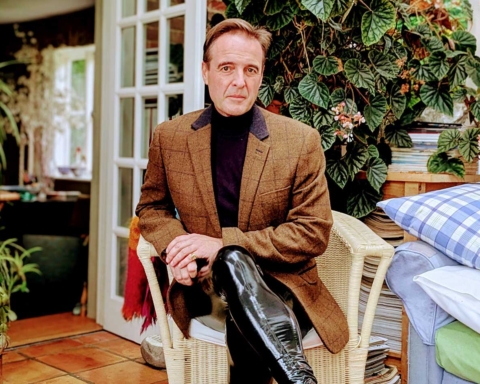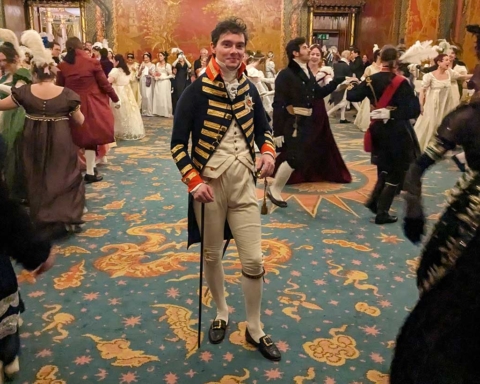Nathaniel Adams:
Oscar Wilde, writer, raconteur, gay icon, large of girth, lust and ego, bottom wobbling provocatively as he climbs the social ladder from the gutter to the stars, then falls back into the muck with a splash, is arguably the most famous dandy ever. In Oscar Wilde, dandyism found its apotheosis, and after his ignoble fall, dandyism’s reputation was tarnished with sin, decadence and evil. But Oscar Wilde had watered, nourished and tended the flower of dandyism until it achieved its brightest and finest bloom yet.
“The future belongs to the dandy. It is the exquisites who are going to rule.” Lord Illingworth, “A Woman of No Importance.”
In 1868, the precocious 13-year-old Wilde wrote a letter home from school, complaining that the shirts his mother had sent were actually his brother’s, as his were “one quite scarlet and the other lilac…” Choosing the words “scarlet” and “lilac” over “red” and “purple” shows Wilde’s early leanings towards dandyism.
A classmate remembered him as “more careful in his dress than any other boy.” When a friend teased him about an ostentatious pair of trousers, he disdainfully replied that he was going to visit Umbria and “these are my Trasimeno trousers, and I mean to wear them there.”

At Oxford, Wilde reinvented himself, starting with one major change: “My Irish accent was one of the many things I forgot at Oxford.” Wilde rehearsed and refined a mellifluous voice– the velvet cushion on which he would present his pearls of eloquence. His university style was unsurprisingly bold: brilliant blue ties, shirts with skyscraper collars, tilted coke hats, and tweeds with giant windowpane checks. He told one friend that even if he “were all alone marooned on a desert island and had my things with me, I should dress for dinner every evening.”
After moving to London, Wilde went to see his tailor. He described a dream in which he had seen a ghostly man in a coat shaped like a cello. He showed his tailor a sketch and the garment was made out of a shimmering brown and red fabric. The coat (paired with a blue satin cravat, brocaded waistcoat, and white gloves,) was a sensation.

Dandyism often has a high price, and Wilde was perpetually in debt. He was sued for unpaid bills to tailors and jewellers, for items including a “Super Fancy Angola Suit.” But Wilde never let mere debt keep him from the important things in life. He furnished his apartments with china, Greek statues, rugs, fresh lilies and an easel bearing an unfinished painting, kept purely for show.
Wilde’s dandyism reached new heights during his tour of America. For the journey, his tailor made him an ankle-length green overcoat with otter fur trim and frogged fastenings. The cuffs were extra-wide and the lapel was deeply notched. After he was seen wearing this ostentatious garb and a Polish cap, the artist Whistler wrote a letter to The World addressed to Oscar saying, “How dare you! What means this unseemly carnival in my Chelsea! Restore these things to Nathan, and never let me find you masquerading the streets in the combined costumes of a degraded Kossuth and Mr. Mantalini!” When Wilde arrived in New York, he greeted the hordes of reporters in his green coat with a matching velvet smoking cap, wide-collared shirt, blue tie and patent leather shoes.
An attendee at one of Wilde’s American lectures describes him wearing, “A dark purple sack coat and knee-breeches; black hose, low shoes with bright buckles, coat lined with lavender satin, a frill of rich lace at the wrists and for tie-ends over a low turn-down collar, hair long, and parted in the middle…circular cavalier cloak over the shoulder.”
A reporter in Washington D.C. described meeting Wilde on the street: “The long-limbed aesthete was attired in a tight-fitting gray ulster, which blew open occasionally and disclosed underneath a pair of velvet knee pants… A pair of black silk stockings and patent-leather low shoes, with large black silk bows, were seen beneath the skirts of the ulster. Round his neck was a wide Byronic collar and a blue bow of the most delicate and ethereal shade, with long streaming ends ‘borne on the soft zephyrs of the morning breeze.’ A very handsome diamond pin was worn in the centre of the bow. On the poet’s noddle reposed a ‘harmony’ in the shape of a polo cap of a peculiar blackish-brownish hue, bound with pink. A pair of semi-gauntleted, flesh-colored kid gloves and a light, fancy cane completed the garb.”
A reporter in Salt Lake City asked Wilde about his sartorial philosophy: “As for my costume, I have several reasons for it, but the more important are these: that the present evening dress of gentlemen is the most objectionable possible, and then I should be glad to do something towards introducing a better. As it is, the Prince of Wales and some of his friends have already pronounced in favor of the velvet coat, ruffles, knee-breeches and silk hose, and it is quite possible that in another year or so all young England may be dressed as I am. Indeed, in New York, one very charming lady has ordered knee-breeches as de rigueur at her receptions, and New York has cheerfully submitted to her delightful tyranny. But another reason for my wearing this costume is based on a principle, for live poets have principles, and that is that one should do as one preaches. Now [William] Morris, the author of that exquisite Earthly Paradise, is prophetically proclaiming the doctrine of artistic dress as a preliminary to a revival of true art; but he goes about himself in the ugliest of nineteenth century clothes. I do not agree with this, so that when you call upon me as you do now, you find me dressed in aesthetic colors. My coat is a pearl grey velvet, my necktie Venetian green, and you see that I spread a fur robe over this hideous sofa before I sit down on it. Tonight, for the same reason, if you come to the theatre, you will find me in black velvet lined with purple, and wearing the ruffles and seals of the Regency.”
Even Wilde’s spirit-breaking time in prison never entirely crushed his dandyism. A letter sent to his friend More Adey just before his release gives a clear insight into the unique psychology of the dandy. In the letter, Wilde requests: “A blue-serge suit from Doré and an ulster, and boots, . . . a brown hat, and a grey hat, soft felt, seaside things, eighteen collars made after the pattern you have, . . . two dozen white handkerchiefs, and a dozen with coloured borders. Also some neckties: some dark blue with white spots and diapers, and some of whatever is being worn for summer wear. I also want eight pair of socks, coloured summer things, . . . two or three sets of plain mother-of-pearl. . . studs. . . . Also, some nice French soap, Houbigant’s if you can get it. . . either ‘Peau d’Espagne’ or ‘Sac de Laitue’ would do: a case of three. Also, some scent; Canterbury Wood Violet I would like, and some ‘Eau de Lubin’ for the toilet, a large bottle. Also some of Pritchard’s tooth-powder, and a medium toothbrush. . . hair-tonic . . . night-shirts. . . with a turn-down collar, and a breast-pocket for a handkerchief: coloured border to collar and cuffs.”

He explained: “I want, for psychological reasons, to feel entirely physically cleansed of the stain and soil of prison life, so these things are all – trivial as they may sound – really of great importance.”









